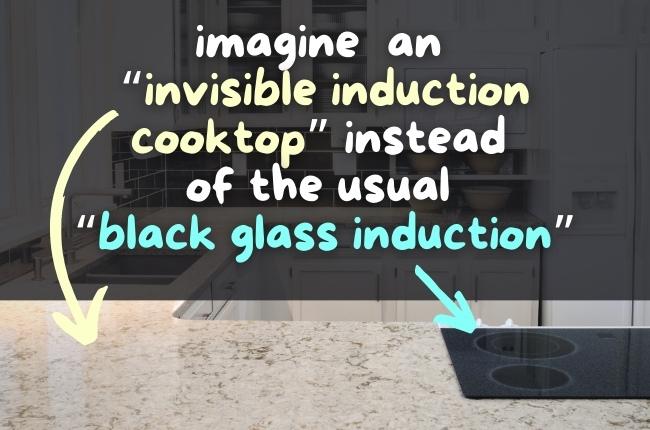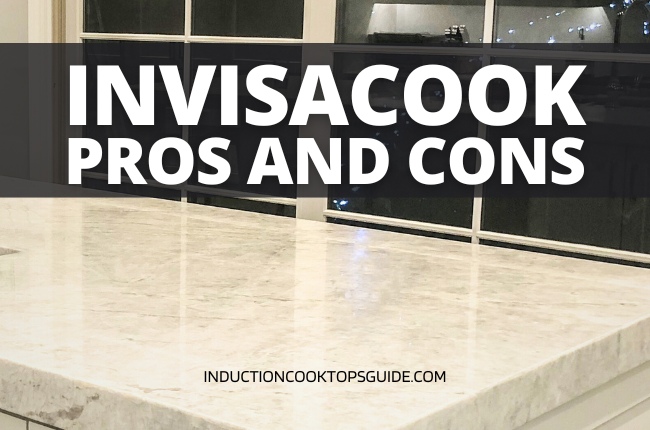An invisible cooktop seems like something straight out of Elon Musk’s brain. As with anything new and innovative, it’s both fascinating and concerning.
After all, induction cooktops have only been a recent addition to kitchens. Isn’t an invisible cooktop too good to be true?
Oh well, it’s not.
At least to Invisacook’s dictionary, a futuristic and aesthetic kitchen is already available. Today, let’s inspect Invisacook pros and cons and assess if the benefits outweigh the potential drawbacks of this latest trend at hand.
What countertops work with Invisacook?

Invisacook is a company that hails itself for the development of an induction hob that goes beneath your countertop.
Since it comes with induction technology, this cooktop offers a better cooking experience and less messy aftermath compared to traditional gas.
FYI: Induction is a method of heating that uses an electromagnetic field to induce the cookware itself to heat up. There’s no visible fire, and the countertop remains relatively cool.
Induction cooktops on the higher end usually have advanced safety features, extensive control panels, and Wi-Fi connection, among others.
All induction cooktops feature the same accurate temperature control and reduced cooking time.
Now, imagine that tech blended on your countertop seamlessly— that is what an invisible cooktop looks like. This way, you can save space, maintain your style and ensure safety and efficiency all at once.
While it may sound like an “out of sight, out of mind” scenario, Invisacook makes safety a number one priority. The control panels can be seen clearly on the countertop, and a noise locator alerts you where to position your pan. You can also control it wirelessly with an app!
FYI: Even though induction does not heat the countertop but the cookware, do note that the cookware may transfer heat to the countertop through conduction.
Despite all the classy and modern appeal of Invisacook, it has all the finicky requirements of induction cooktops, i.e., it requires compatible cookware, specific electrical requirements, professional installment, and a quite wide learning curve.
Oh! And there’s one more requirement you don’t see on an average induction cooktop: the countertop’s material.
Cookware
An induction-compatible pan or pot has a magnetic base. If you stick a magnet to it, it will not slide down or drop.
Cast iron (raw or enameled) and magnetic stainless steel are perfect examples. You can use multi-layered cookware as long as they contain ferromagnetic material, especially at the bottom.
All-copper, all-aluminum, and glass are not compatible. Ensure you see the induction logo when purchasing cookware for your Invisacook. Or bring a magnet and test it yourself!
If you find it tiresome to shop for a cookware set, Invisacook has a 10-piece set available that works perfectly with their cooktop.
Electrical requirements and installation
According to Invisacook’s website, you’d need a “220v twist lock receptacle for the 2-3-4 and 5 burner unit and a 110v receptacle for 1- and 2- units”. An installation video is available on their website should you need a reference.
Countertop material
Alas, Invisacook adds to the list of specific requirements that only materials made of granite, porcelain, ceramic, and ultracompact surfaces can work with their technology. As an aid, Invisacook provides a list of approved porcelain countertop brands that you can check out.
If you are yet to get your countertop, Invisacook primarily suggests a 12mm thick, large format porcelain or a 1.5 cm-milled granite material for your cooktop area.
Invisacook also requires all its users to use the Invisamat— a silicone heat diffuser— to extend the lifespan of your induction stove. This is especially useful when you plan to use cast iron. Cast iron cookware retains heat very well, and while this heat makes for good cooking, prolonged exposure of the countertop to heat may damage it eventually.
Does InvisaCook work with Quartz?
Invisacook recommends porcelain, granite, and marble as countertop materials you can select from. All three have one thing in common: they are all-natural stones.
Quartz is not an all-natural stone.
Quartz countertops are engineered stones composed of 90% quartz with 10% resin and pigments. As a man-made stone, it’s harder than natural stones, which makes it more resistant to cracks, scratches, and chipping.
Its non-porous quality makes it stain-resistant and requires less maintenance. However, even with its durability and customizability, it is vulnerable to heat damage.
If you are not the type to use a trivet or hot pad, you’ll likely gradually melt the resin that’s holding those quartz particles together with excessive and prolonged heat exposure.
Granite and porcelain, on the other hand, can sustain high temperatures. Porcelain requires about 2600 F to crack, while granite only melts at about 2200-2300 F. It is highly heat resistant; granite only shows signs of cracking when a 1300F hot cast iron is placed on it.
You should make it a good practice never to place a scorching hot object directly on your porcelain or granite countertop. They won’t crack but will stain!
All-natural stone is a required material for Invisacook. Engineered stones like quartz or cultured marble are not compatible, so you should veer off from them when choosing countertops.
Another example of an all-natural stone is quartzite. While it sounds like a little sister to quartz, don’t be fooled!
Quartzite has similar features to marble and granite with its delicate veining, color, and pattern. It often comes in white or light gray and has a lot of movement to its natural design. Like other all-natural stones, quartzite needs more upkeep due to its higher tendency to stain.
How expensive is Invisacook?
One of the possible cons with Invisacook is its price. Equipped with both beauty and function, Invisacook isn’t the most affordable kitchen purchase out there.
However, if you’re looking to remodel your kitchen space and create a more efficient and appealing cooktop to integrate into your home life, then it’s worth investing.
The Invisacook price range is wide. It’s best to talk directly with the dealer they listed for your area.
To give you an idea, it will cost you about $1000-$3000. As a comparison, that’s as much as the Bosch Benchmark induction series.
The price varies depending on how many burners you want to install on your countertop. Currently, Invisacook has four models: 1-burner 110V, 2-burner 110V or 220V, 4-burner 220V, and a 5-burner 220V.
When considering how many burners you want to install, what you want to do is consider your budget first. The cost does not stop at installation but also involves general maintenance as well as electric bills. They hike up as you have more burners!
As seen on Southbay Green Design’s website, the 1-burner Invisacook has a trade price of $975 and a retail price of $1100.
As you add more burners, the difference between the trade and retail price gets higher too.
For example, a 2 burner Invisacook costs $1550 in trade price but $1700 once in retail. That’s a $150 increase compared to the $125 difference on the 1-burner Invisacook.
The Invisacook 4 burner cost jumps within the $2700-$3000 range. Meanwhile, the Invisacook 5 burner price has a trade price of $3100 but goes on retail for $3400. Both have a $300 increase once you buy them from a retailer.
Overall, it’s the iPhone dilemma. It looks pretty and functions efficiently but also requires a deeper pocket than your regular kitchen appliance.
As it is pretty new, there’s no certainty it will be a wise investment. However, the science of induction— the ultimate heart of this innovation— has proven true to its promise.
So, what do people say about Invisacook?
READ MORE: Why are induction cooktops so expensive?
Invisacook reviews online
Invisacook is the new kid on the block, so only a few people have taken it to trial. Most are commercial reviews, so you need to take it with a grain of salt.
Below is a summary of the reviews found in Houzz:
- The 110V option, predictably, doesn’t heat as quickly as the 220V counterparts. As one review said, the 110V is better for keeping food warm while showing off to your friends.
- It takes too long to boil water compared to a regular induction cooktop. If you are the type to use high temperatures when cooking, you may find this a problem.
- When sourcing for a countertop, the reviews state that 12-mm porcelain (as Invisacook recommended) is the material of choice.
- A 2-burner shares its power (maxed at 10). If you turn on both burners, their power levels must add up to 10. The 4-burner Invisacook might be too close to each other, so a two 2-burner spaced at a comfortable distance is better than a single 4-burner.
- Like a regular induction cooktop, the compatible cookware must not be too large nor too small for the burner zone.
After learning all that, now we can list out the Invisacook Pros and Cons.
Invisacook Pros
- Space saving – no need for a separate countertop space for the induction stove.
- Sleek, modern aesthetic – your cooktop and countertop all look the same. There’s no black glass cooktop that can ruin your kitchen aesthetic.
- No open flame, no risk of burns, and safer for kids – basically, all the pros that come with induction cooking 🙂
Invisacook Cons
- Only works with specific countertop surfaces like porcelain, granite and marble.
- Only works with specific cookware – Not all “induction-ready” cookware works with the Invisacook. Cast iron, although induction-compatible, is not recommended for the Invisacook as it retains high heat and may damage the countertop. Invisacook offers their own cookware line. But stainless steel with magnetic bottom and full clad stainless steel can work on the Invisacook.
- Needs professional installation
- Pricey – it’ll cost you at least $1,000, and that’s just for the 1 burner unit. The more burners you have, the more expensive it gets.

Leave a Reply